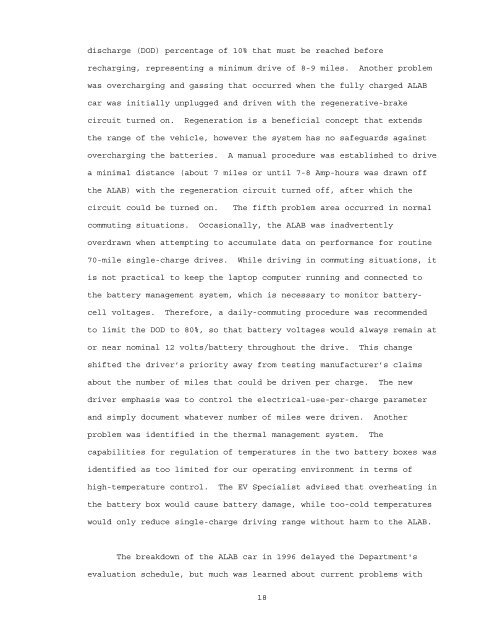Evaluation of Electric Vehicles as an Alternative for Work Trip and ...
Evaluation of Electric Vehicles as an Alternative for Work Trip and ...
Evaluation of Electric Vehicles as an Alternative for Work Trip and ...
You also want an ePaper? Increase the reach of your titles
YUMPU automatically turns print PDFs into web optimized ePapers that Google loves.
discharge (DOD) percentage <strong>of</strong> 10% that must be reached be<strong>for</strong>e<br />
recharging, representing a minimum drive <strong>of</strong> 8-9 miles. Another problem<br />
w<strong>as</strong> overcharging <strong>an</strong>d g<strong>as</strong>sing that occurred when the fully charged ALAB<br />
car w<strong>as</strong> initially unplugged <strong>an</strong>d driven with the regenerative-brake<br />
circuit turned on. Regeneration is a beneficial concept that extends<br />
the r<strong>an</strong>ge <strong>of</strong> the vehicle, however the system h<strong>as</strong> no safeguards against<br />
overcharging the batteries. A m<strong>an</strong>ual procedure w<strong>as</strong> established to drive<br />
a minimal dist<strong>an</strong>ce (about 7 miles or until 7-8 Amp-hours w<strong>as</strong> drawn <strong>of</strong>f<br />
the ALAB) with the regeneration circuit turned <strong>of</strong>f, after which the<br />
circuit could be turned on. The fifth problem area occurred in normal<br />
commuting situations. Occ<strong>as</strong>ionally, the ALAB w<strong>as</strong> inadvertently<br />
overdrawn when attempting to accumulate data on per<strong>for</strong>m<strong>an</strong>ce <strong>for</strong> routine<br />
70-mile single-charge drives. While driving in commuting situations, it<br />
is not practical to keep the laptop computer running <strong>an</strong>d connected to<br />
the battery m<strong>an</strong>agement system, which is necessary to monitor battery-<br />
cell voltages. There<strong>for</strong>e, a daily-commuting procedure w<strong>as</strong> recommended<br />
to limit the DOD to 80%, so that battery voltages would always remain at<br />
or near nominal 12 volts/battery throughout the drive. This ch<strong>an</strong>ge<br />
shifted the driver’s priority away from testing m<strong>an</strong>ufacturer’s claims<br />
about the number <strong>of</strong> miles that could be driven per charge. The new<br />
driver emph<strong>as</strong>is w<strong>as</strong> to control the electrical-use-per-charge parameter<br />
<strong>an</strong>d simply document whatever number <strong>of</strong> miles were driven. Another<br />
problem w<strong>as</strong> identified in the thermal m<strong>an</strong>agement system. The<br />
capabilities <strong>for</strong> regulation <strong>of</strong> temperatures in the two battery boxes w<strong>as</strong><br />
identified <strong>as</strong> too limited <strong>for</strong> our operating environment in terms <strong>of</strong><br />
high-temperature control. The EV Specialist advised that overheating in<br />
the battery box would cause battery damage, while too-cold temperatures<br />
would only reduce single-charge driving r<strong>an</strong>ge without harm to the ALAB.<br />
The breakdown <strong>of</strong> the ALAB car in 1996 delayed the Department's<br />
evaluation schedule, but much w<strong>as</strong> learned about current problems with<br />
18
















